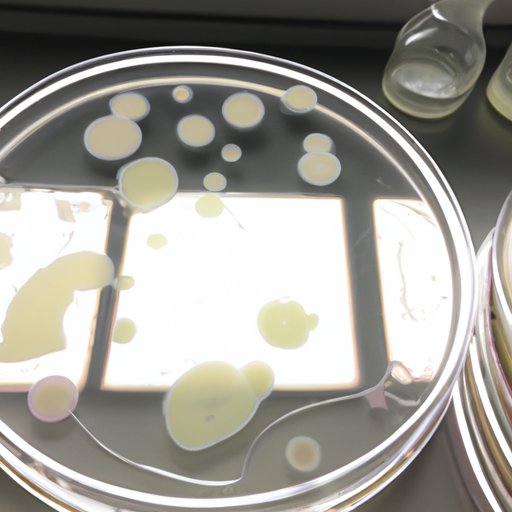Introduction
A pure culture is a population of identical cells or organisms that are derived from a single parent cell or organism. This type of culture is used in many different fields of science, especially in microbiology. In this article, we will explore the definition of a pure culture, its role in microbiology, and the benefits of working with it.

A Detailed Look at What is a Pure Culture
To understand what a pure culture is, it is important to first define what a culture is. A culture is a collection of living organisms, such as bacteria, fungi, or other microorganisms, grown in a laboratory environment on a solid or liquid medium. Depending on the type of culture, the organisms may be grown in suspension, on a surface, or in a broth.
Pure cultures are distinguished from mixed cultures because they contain only one type of organism. Mixed cultures, on the other hand, contain more than one type of organism. This distinction is important because it allows scientists to study the behavior and characteristics of a single organism without interference from other organisms. As a result, pure cultures are essential for accurate research and diagnosis in microbiology.
Examples of pure cultures include bacterial cultures, fungal cultures, and viral cultures. Bacterial cultures are used to study the growth and behavior of bacteria, while fungal cultures are used to study the growth and behavior of fungi. Viral cultures are used to study the growth and behavior of viruses.

Exploring the Definition of Pure Cultures
In order to better understand the definition of a pure culture, it is important to look at the characteristics of a pure culture. According to the American Society for Microbiology (ASM), a pure culture is “a population of cells or organisms that are genetically identical and have arisen from a single ancestor”. This means that all of the cells or organisms in a pure culture have the same genetic makeup, which ensures that they have the same characteristics and behavior.
In addition to being genetically identical, pure cultures must also be free of contamination. Contamination can occur when foreign organisms, such as bacteria or fungi, enter the culture and disrupt the growth of the desired organism. To prevent contamination, pure cultures are usually grown in a sterile environment and handled with sterile equipment.

The Role of Pure Cultures in Microbiology
Pure cultures play an important role in the field of microbiology. They are essential for accurate research and diagnosis, as they allow scientists to study the behavior and characteristics of a single organism without interference from other organisms. Pure cultures are also used to identify and classify organisms, as each organism has unique characteristics that can be used to distinguish it from other organisms.
Pure cultures are also used to study the interaction between different types of microorganisms. By studying the interactions between different species of microorganisms, scientists can gain insight into how these organisms interact with each other and how they affect their environment. This knowledge can then be used to develop new treatments and therapies for diseases caused by microorganisms.
How to Culture a Pure Culture
Before a pure culture can be cultured, a suitable medium must be prepared. The medium must provide the necessary nutrients for the organisms to grow, as well as the correct environmental conditions for them to thrive. Once the medium is prepared, the organisms can be isolated and cultured using various techniques, such as streak plate technique, pour plate technique, and spread plate technique.
Once the organisms have been isolated and cultured, they can be identified and classified. This is done by examining the characteristics of the organisms under a microscope, such as shape, size, color, and motility. Once the organisms have been identified, they can be examined further to determine their function and environment.
Benefits of Working with Pure Cultures
Working with pure cultures has many advantages. One of the most significant benefits is improved accuracy in microbiological studies. Since only one type of organism is present in a pure culture, the results of a study are not affected by the presence of other organisms. This allows scientists to make more reliable conclusions about the behavior and characteristics of a particular organism.
Another benefit of working with pure cultures is reduced risk of contamination. When working with mixed cultures, there is always a risk of contamination from the other organisms present. However, when working with pure cultures, the risk of contamination is minimized, as only one type of organism is present.
Finally, working with pure cultures can increase understanding of microbial interactions. By studying the interactions between different species of microorganisms, scientists can gain insight into how these organisms interact with each other and how they affect their environment. This knowledge can then be used to develop new treatments and therapies for diseases caused by microorganisms.
Conclusion
Pure cultures are an important tool in the field of microbiology. They are essential for accurate research and diagnosis, as they allow scientists to study the behavior and characteristics of a single organism without interference from other organisms. In addition, they can be used to identify and classify organisms, as well as to study the interactions between different types of microorganisms. Finally, working with pure cultures has many benefits, including improved accuracy in microbiological studies, reduced risk of contamination, and increased understanding of microbial interactions.
(Note: Is this article not meeting your expectations? Do you have knowledge or insights to share? Unlock new opportunities and expand your reach by joining our authors team. Click Registration to join us and share your expertise with our readers.)
